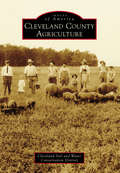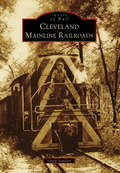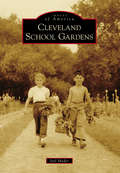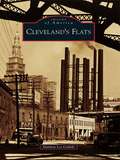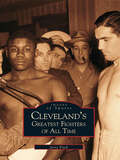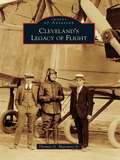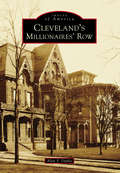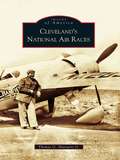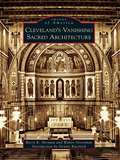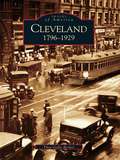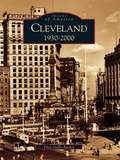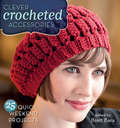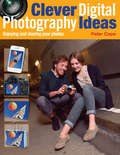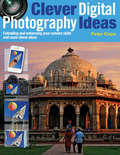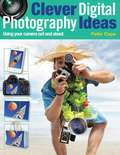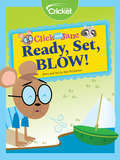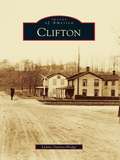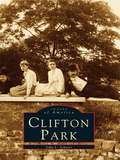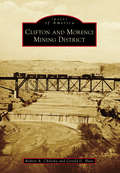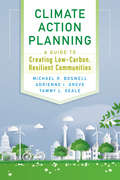- Table View
- List View
Cleveland County Agriculture (Images of America)
by Cleveland Soil and Water Conservation DistrictNestled in the foothills of the Blue Ridge Mountains in southwestern North Carolina, Cleveland County has long been cultivated. Before the Civil War, self-reliant farms grew and raised a diverse array of vegetables, field crops, and livestock. These small farms relied on family labor, draft animals, waterwheels, and ingenuity. Eventually, the county became a leader in production of cotton and dairy products; tractors, combines, and hay balers became farm mainstays. Cleveland County Agriculture showcases the triumphs and trials of farmers--farmers who endured the Great Depression, the arrival of the boll weevil, and the everyday challenges of farm life.
Cleveland Mainline Railroads
by Craig SandersIn the 1800s, railroad development was instrumental in enabling Cleveland to become an industrial center. By 1920, Cleveland was the nation's fifth-largest city, with an economy dependent on the iron and steel, petroleum-refining, automotive, and chemical industries. It was second only to Detroit among American cities in the percentage of the population employed by industry. Railroads brought raw materials needed for manufacturing and carried the finished products to markets everywhere. The mainline railroads serving Cleveland included the Baltimore & Ohio, the Erie, the New York Central, the Nickel Plate Road, the Pennsylvania, and the Wheeling & Lake Erie. Images of Rail: Cleveland Mainline Railroads describes how these six railroads developed and what freight and passenger markets they served through the 1960s, a period during which railroads were the primary carriers of goods and passengers to Cleveland. Industry changed following World War II, leading to the consolidation and abandonment of railroad routes in northeast Ohio.
Cleveland School Gardens (Images of America)
by Joel MaderThe Cleveland Public School's tract garden program was one of the most successful and innovative programs of the school system. The organization and beauty of the gardens attracted horticulture educators from all over the United States, South America, and as far away as Japan. From its humble beginnings in 1904 as a project to beautify vacant lots in Cleveland, it grew into an educational tool that taught thousands of children the respect for nature and its bounty. At the tract gardens' height, the amount of land under cultivation in the middle of the Cleveland urban landscape approached 100 acres. By 1970, there were 27 horticultural centers servicing all Cleveland schools. Centers were located next to schools, in housing estates, at fairgrounds, at a home for the aged, and on museum property. A few of the centers are now neighborhood gardens. The photographs in Cleveland School Gardens show that the Cleveland Public Schools knew the importance of being "green" 100 years before it was politically fashionable.
Cleveland's Flats
by Matthew Lee GrabskiCleveland is home to many fascinating neighborhoods and districts. Perhaps the most intriguing, however, is an area known as the Flats. Typically, the term "Flats" refers to the northern portion of the Cuyahoga River Valley. The Cuyahoga River ceases to be the idyllic flow of water seen to the south of Cleveland as it approaches the city's steel mills. The river is more man-made than natural where it meets the Flats, and a wide array of industries sit along its banks. The Flats have been a vital component and a reflection of Cleveland's rise, decline, and ongoing renaissance. Cleveland's Flats is a chronicle of this remarkable region. From the refineries of Standard Oil to massive ore boats carefully navigating the Cuyahoga, Cleveland's Flats treats the reader to scenes found in no other place.
Cleveland's Greatest Fighters of All Time (Images of Sports)
by Jerry FitchBoxing began in Cleveland in the 1880s. As pugilism was an illegal activity, brawling workers from the iron ore docks surreptitiously met on "Whiskey Island" to settle disputes. They would be followed by crowds of spectators who cheered them on and often ended up fleeing from the sheriff. Boxing grew in popularity and soon became a legitimate sport that brought packed houses to such local venues as Cleveland Municipal Stadium, the Cleveland Arena, and the Public Auditorium. Thousands of fans from across the country would come to Cleveland to attend the marquee bouts of many of the city and the nation's most celebrated fighters.Cleveland's Greatest Fighters of All Time follows the amazing careers of the city's most popular and successful boxers, highlighted by more than 100 rarely-seen images. From the speedy and resilient Johnny Kilbane, Cleveland's first great champion, to the heroic Jimmy Bivins, a true champion in and out of the ring, these stories of triumph and heartbreak are to be enjoyed by boxing fans of all eras. Much of the action inside is described in such a way as to bring the reader ringside.
Cleveland's Legacy of Flight (Images of Aviation)
by Thomas G. Matowitz Jr.Since the dream of flight was finally realized by two Ohioans, Wilbur and Orville Wright, it is little wonder that Greater Clevelanders were quick to embrace it. From the August day in 1910 when Glenn Curtiss flew from Euclid Beach Park to Cedar Point, aviation has had a strong following in Cleveland. World War I saw the dawn of aircraft production in the city, and the 1920s brought the world-renowned Cleveland National Air Races. Cleveland industry supported aviation in many different ways, and multiple airports, many now long gone, promoted business aviation and flight training for decades. During World War II, Cleveland was a center of war production, and much of this was aviation related. Subsequently, renovations of the Cleveland Municipal Airport created Cleveland Hopkins International Airport. A scene of thriving airline operations to this day, Cleveland's business community was quick to appreciate the advantages of corporate aviation, which remains a daily feature of Cleveland's aviation life.
Cleveland's Millionaires' Row (Images of America)
by Alan F. DutkaThe incredible affluence and extravagance of Euclid Avenue's Millionaires' Row have fascinated Clevelanders for more than a century. Within these stately mansions, US presidents enjoyed dinners and discussions with powerful politicians and influential industrial and banking leaders. Through photographs and meticulously researched captions, Cleveland's Millionaires' Row provides authoritative visual and written answers to the most often-asked questions regarding the famous avenue: where were these mansions located, how did their occupants acquire such enormous wealth, what caused the street's demise, and what replaced the famous old homes? The book also reveals the progress in remaking Euclid Avenue's four-mile stretch from Public Square to University Circle. Cleveland's Millionaires' Row vividly illustrates the birth, glamor, decline, and renaissance of the grand old avenue.
Cleveland's National Air Races (Images of America)
by Thomas G. Matowitz Jr.Enthusiasm for aviation exploded after Charles Lindbergh's solo flight across the Atlantic in May 1927. The National Air Races, held in Cleveland between 1929 and 1949, collectively represent one of the most significant aviation events of the 20th century. Cleveland's newly constructed municipal airport, the world's largest airport facility at the time, along with its permanent 50,000-seat bleachers, won the city hosting rights to the event. The National Air Races captivated the public during the grim years of the Great Depression and provided a showcase for many aviation innovations including retractable landing gear, low-wing monoplanes, aircooled engines, and careful streamlining. A deadly crash ended the National Air Races more than 50 years ago, but the races made an unforgettable impression. This book should reinforce the memories of those who saw the races firsthand and pique the interest of those who have always wished they had.
Cleveland's University Circle (Images of America)
by Wayne KehoeFrom art exhibitions and natural wonders of the planet to world-class music and dazzling theater, University Circle is Cleveland's cultural, educational, and civic showpiece. Found in its one square mile are arts and sciences, museums and parks, galleries and restaurants. The circle area began as the turnaround for the Euclid Avenue streetcar in the 19th century and has developed into the cultural capital of Cleveland, as it is home to the Cleveland Museum of Art, the Cleveland Cultural Gardens, Case Western Reserve University, and the Cleveland Orchestra. Its buildings and gardens are only part of the story; the people are at the real heart of the circle--from such philanthropists as John D. Rockefeller and Jeptha Wade to Dr. George Crile and the Mathers family. And then there are the multitudes of students, immigrants, and workers who have called the circle their home.
Cleveland's Vanishing Sacred Architecture
by Walter Grossman Barry K. HermanAs in other cities, Cleveland has developed through the evolution of its European ethnic neighborhoods and their various religions. Many of these neighborhoods built their own churches, which became the focus of community development and unity. For decades, these churches thrived, but the new millennium has brought with it huge changes in the economy. Large "membership" institutions, like the Catholic Church, have had to make the toughest of decisions--closing churches that were thought to be a permanent part of the local landscape. The authors of this book feel it is important to preserve the memory of these significant religious, cultural, and social institutions so that the current and future generations do not forget them. The pictures of these incredible places take on a whole new meaning when coupled with the fact that they will soon be gone. These pages celebrate the architecture, art, and artifacts of these sacred structures in high-quality photographs and explanations.
Cleveland: 1796-1929 (Images of America)
by Thea Gallo BeckerLocated on the southern shores of Lake Erie, Cleveland was founded in 1796 by General Moses Cleaveland, an agent of the Connecticut Land Company surveying the Western Reserve. The modest frontier settlement became a village in 1815 and an incorporated city in 1836. By 1896, Cleveland boasted the Cuyahoga Building, the Soldiers and Sailors Monument, the Arcade, and the stately mansions of Euclid Avenue. Also known as "Millionaire's Row," it was home to Cleveland's industrial, commercial, cultural, and political elite, including Tom L. Johnson, a streetcar magnate and arguably Cleveland's finest mayor, and John D. Rockefeller, the founder of the Standard Oil Company and the nation's first billionaire. In the history of Ohio, no city has been more populous, prosperous, and influential. Cleveland can credit its growth and strength as a city to its wealth of diversity.
Cleveland: 1930-2000 (Images of America)
by Thea Gallo BeckerCleveland: 1930-2000 is the second of two volumes commemorating the history of the heart and pride of northeast Ohio, the city of Cleveland. Situated on the shores of Lake Erie, Cleveland emerged as an industrial and commercial giant at the end of the Nineteenth Century, earning herself the title of America's "Sixth City" as her population soared, nearing one million. Like many American manufacturing giants, Cleveland experienced a period of decline in industry and commerce, and as with many other urban areas, civil rights issues threatened to rip apart the fabric of the city. Yet, Cleveland emerged from these tumultuous times with a renewed commitment for a better future. Explore Cleveland's golden age, her decline, and her rebirth with this commemorative photographic history.
Clever Cookie Cutter: How to Make Creative Cookies with Simple Shapes
by Jen RichEverybody loves delicious, perfectly decorated cookies - the kind that look almost too good to eat (not that that ever stopped us). But who needs a whole drawerful of cookie cutters in every shape and size that gets left to collect dust in the dark corners of your kitchen, never to be used again?Clever Cookie Cutter will show you how to create 30 incredible cookie designs using just 3 simple cookie cutters - a heart, a gingerbread man and a star. From fabulous flamingos to bootylicious bums and boobs or out-of-this-world aliens to magical unicorns, this little book will have you covered no matter the occasion or your mood. And handy tips and techniques, plus basic dough and icing recipes, make cookie decorating a breeze, no matter your level of skill (or patience). So you'll be able to impress your friends, delight your family and maybe even surprise yourself along the way.- Transform heart-shaped cookies into fabulous flamingos, sumptuous strawberries and beautiful butterflies.- Turn gingerbread men into luscious monstera, fearsome sharks or spooky zombies.- Take star-shaped cookies and turn them into purr-fect cats, magical unicorns and spring-time daffodils.- Plus, pick up handy tips and techniques for the best cookies you've ever made.
Clever Cookie Cutter: How to Make Creative Cookies with Simple Shapes
by Jen RichEverybody loves delicious, perfectly decorated cookies - the kind that look almost too good to eat (not that that ever stopped us). But who needs a whole drawerful of cookie cutters in every shape and size that gets left to collect dust in the dark corners of your kitchen, never to be used again?Clever Cookie Cutter will show you how to create 30 incredible cookie designs using just 3 simple cookie cutters - a heart, a gingerbread man and a star. From fabulous flamingos to bootylicious bums and boobs or out-of-this-world aliens to magical unicorns, this little book will have you covered no matter the occasion or your mood. And handy tips and techniques, plus basic dough and icing recipes, make cookie decorating a breeze, no matter your level of skill (or patience). So you'll be able to impress your friends, delight your family and maybe even surprise yourself along the way.- Transform heart-shaped cookies into fabulous flamingos, sumptuous strawberries and beautiful butterflies.- Turn gingerbread men into luscious monstera, fearsome sharks or spooky zombies.- Take star-shaped cookies and turn them into purr-fect cats, magical unicorns and spring-time daffodils.- Plus, pick up handy tips and techniques for the best cookies you've ever made.
Clever Crocheted Accessories: 25 Quick Weekend Projects
by Brett BaraCrocheters will satisfy their hunger for unique small projects with formerCrochet Todayeditor Brett Bara’sClever Crocheted Accessories. Brett, the former editor ofCrochet Today, collected 25 delightful, practical pieces that make perfect gifts-though you may be tempted to keep them all to yourself! The ideal curator, Brett shares a first-rate lineup of projects. Whether you are a beginner or experienced crocheter, there is something for everyone: hats and caps, including a cloche, porkpie hat, and tam; scarves, shawls, and cowls, from chunky to drapey to snug; eye-catching mittens and arm warmers; delicate lace socks and cozy man-slippers; flirty bags; and sparkly jewelry. Each piece is designed with standout details so that even the simplest pattern has that "wow” factor by showcasing lust-worthy yarn, an unexpected technique, or a fun embellishment. Techniques you'll discover include Tunisian crochet, broomstick lace, and Bruges lace. The all-star roster of designers includes Robyn Chachula, Doris Chan, Mari Lynn Patrick, Regina Gonzalez, Drew Emborsky, Linda Permann, Kristin Omdahl, Ellen Gormley, Cal Patch, Pamela Wynne, Linda Cyr, and Vickie Howell.
Clever Digital Photography Ideas
by Peter CopeA practical, accessible guide to the ingenious and creative things that can be done with a digital compact or camera phone. Clever Digital Photography Ideas: Starting to make the most of your camera or camera phone is a chapter from the book 100 Clever Digital Photography Ideas and provides a variety of simples ideas for getting even more from your camera or camera phone than just a record of those memorable moments. This includes exploring the camera's functions, ingenious ways to record information and photography your hobbies and interests.All ideas and projects are presented with easy to follow instructions and striking photographs across colourful pages. Open your eyes to the creative possibilities with your digital photo technology, from using a basic compact camera to the latest smart phone. Whether a novice or a pro, Clever Digital Photography Ideas: Starting to make the most of your camera or camera phone will show you how to break out of your comfort zone and try something exciting and new.
Clever Digital Photography Ideas - Enjoying and sharing your photos
by Peter CopeA practical, accessible guide to the ingenious and creative things that can be done with a digital compact or camera phone. Clever Digital Photography Ideas: Enjoying and sharing your photos is an extract from the book 100 Clever Digital Photography Ideas and provides a variety of simples ideas to take your photographs beyond the photo frame or photo album. Digital technology has meant that you can print on almost anything in virtually any size, from everyday canvases to the more creative mobile phone cases, and wallpaper! You can create your own Hockney joiner or Banksy style artwork, and you can share your photos online through websites and blogs. There are even clever ideas for selling your photographs.All ideas and projects are presented with easy to follow instructions and striking photographs across colourful pages. Open your eyes to the creative possibilities with your digital photo technology, from using a basic compact camera to the latest smart phone. Whether a novice or a pro, Clever Digital Photography Ideas: Enjoying and sharing your photos will show you how to break out of your comfort zone and try something exciting and new.
Clever Digital Photography Ideas - Extending and enhancing your camera skills and more clever ideas
by Peter CopeA practical, accessible guide to the ingenious and creative things that can be done with a digital compact or camera phone. Clever Digital Photography Ideas: Extending and enhancing your camera skills and more clever ideas is an extract from the book 100 Clever Digital Photography Ideas and provides a variety of simples ideas for pushing your camera skills that little but further. From how you can shoot when conditions get a bit extreme, to creating breath-taking panoramas, and even three-dimensional photos. Shooting movies is also covered, with some ingenious ideas to become more creative in the movie-making arena. There are also clever ideas for protecting your photos for the future, including shooting in RAW. The second part of the eBook covers getting more from your camera and camera phone, guiding you through what all the buttons and jargon mean, as well as clever ideas for extending your battery life and fun ways to use your old camera.All ideas and projects are presented with easy to follow instructions and striking photographs across colourful pages. Open your eyes to the creative possibilities with your digital photo technology, from using a basic compact camera to the latest smart phone. Whether a novice or a pro, Clever Digital Photography Ideas: Extending and enhancing your camera skills and more clever ideast will show you how to break out of your comfort zone and try something exciting and new.
Clever Digital Photography Ideas: Using Your Camera Out and About
by Peter CopeA practical, accessible guide to the ingenious and creative things that can be done with a digital compact or camera phone. Clever Digital Photography Ideas: Using Your Camera Out and About is a chapter from the book 100 Clever Digital Photography Ideas and provides a variety of simples ideas for getting more from your camera or camera phone when you are out and about, beyond your travels and holidays. Some ideas might be obvious, like tips for shooting landscapes, but many are more obscure and fun, like creating a visual gift list and using your camera as binoculars. With so many people owning camera phones these days, there's no excuse not to be taking photographs whilst you are out and about.All ideas and projects are presented with easy to follow instructions and striking photographs across colourful pages. Open your eyes to the creative possibilities with your digital photo technology, from using a basic compact camera to the latest smart phone. Whether a novice or a pro, Clever Digital Photography Ideas: Using Your Camera Out and About will show you how to break out of your comfort zone and try something exciting and new.
Click and Jane: Ready, Set, Blow!
by Rob McClurkanClick, Jane, and CeCe are crafting toy sailboats! Once the paint dries, they get some exercise and learn about breathing on their way to race their sailboats in the creek. Jane exercises regularly, so breathing is much easier for her! Once the race is underway, who will win?
Click! A Story about George Eastman
by Barbara MitchellFollows the life and career of the man who revolutionized photography by developing a camera simple enough for anyone to use.
Clifton
by Lynne Garvey-HodgeThe historic town of Clifton, Virginia, is an enchanting relic of a time past. This quarter-mile-square town of 225 inhabitants has seen little change since the early 20th century. Twenty-seven miles from the nation's capital, this little gem of yesterday is often missed by busy commuters. Clifton was originally a Native American hunting ground, then a large plantation, and eventually became known as Devereux Station, named for J. H. Devereux, overseer of the Union army's railroad construction. Harrison Otis settled here and built the handsome Clifton Hotel. Local hot springs, shops, lumber industry, schools, and churches soon created a thriving, progressive area of commerce. Originally named Clifton Station, Clifton was later incorporated in 1902. It was the first community in Fairfax County with a black Baptist church, electricity, and a high school, and it has hosted visitors as varied as Presidents Hayes and Garfield, actress Helen Hayes, First Lady Nancy Reagan, and Sleepless in Seattle author Jeff Arch. Clifton has been and is still a gentle, picturesque village.
Clifton Park (Images of America)
by John L. SchererVivid and entrancing, the images of Clifton Park contained within this volume span more than a century of memories. Residents of the area, both natives and newcomers, will find a strong connection with the faces and places presented. Rare photographs of Clifton Park, many never before published, provide a glimpse of life from 1875 to 1950. We experience the area's gradual transition, from its agricultural roots through the era of the Erie Canal and the railroads to the early years of the automobile. Through pictures of local industries, shaded dirt roads, homes, and amusement parks, we learn how early Clifton Park residents worked and played. The book also features views of local taverns, general stores, churches, and schools--all the foundations of a changing, strong, and growing community.
Clifton and Morenci Mining District
by Robert A. Chilicky Gerald D. HuntAcross America, from big cities to small towns and rural hamlets, there are many stories of challenges, historic events, courageous people, tragedy, and success. Some of the best and most exciting tales may not be well known. Such is the case for the towns of Clifton and Morenci, Arizona. They survived labor strikes, rising and falling copper prices, devastating floods, outlaws and lawlessness, gambling houses, and saloons. All this added to the lore that these towns were some of the roughest communities in the West. Today, after 143 years of mining, Freeport-McMoRan's Morenci copper mine is the largest in North America. Expansion has required new homes in Clifton-Morenci, a modern library, and recreational facilities. Residents are proud of their communities.
Climate Action Planning: A Guide to Creating Low-Carbon, Resilient Communities
by Michael R. Boswell Adrienne I. Greve Ms Tammy L. SealeClimate change continues to impact our health and safety, the economy, and natural systems. With climate-related protections and programs under attack at the federal level, it is critical for cities to address climate impacts locally. Every day there are new examples of cities approaching the challenge of climate change in creative and innovative ways—from rethinking transportation, to greening city buildings, to protecting against sea-level rise. Climate Action Planning is designed to help planners, municipal staff and officials, citizens and others working at local levels to develop and implement plans to mitigate a community's greenhouse gas emissions and increase the resilience of communities against climate change impacts. This fully revised and expanded edition goes well beyond climate action plans to examine the mix of policy and planning instruments available to every community. Boswell, Greve, and Seale also look at process and communication: How does a community bring diverse voices to the table? What do recent examples and research tell us about successful communication strategies? Climate Action Planning brings in new examples of implemented projects to highlight what has worked and the challenges that remain. A completely new chapter on vulnerability assessment will help each community to identify their greatest risks and opportunities. Sections on land use and transportation have been expanded to reflect their growing contribution to greenhouse gas emissions. The guidance in the book is put in context of international, national, and state mandates and goals. Climate Action Planning is the most comprehensive book on the state of the art, science, and practice of local climate action planning. It should be a first stop for any local government interested in addressing climate change.
